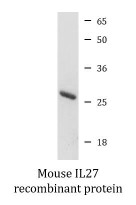ARG70179
Mouse IL27 recombinant protein (Active) (His-tagged, C-ter)
Mouse IL27 recombinant protein (Active) (His-tagged, C-ter) for SDS-PAGE
Overview
| Product Description | E. coli expressed, His-tagged (C-ter) Active Mouse IL27 recombinant protein |
|---|---|
| Tested Application | SDS-PAGE |
| Target Name | IL27 |
| Species | Mouse |
| A.A. Sequence | Phe29 - Ser234 |
| Expression System | E. coli |
| Activity | Active |
| Activity Note | Determined by its ability to protect HepG2 cells infected with encephalomyocarditis (EMC) virus. The ED50 for this effect is < 5 ng/mL. |
| Alternate Names | IL27; Interleukin 27; IL27A; P28; IL27p28; IL-27A; IL-27; IL30; Interleukin-27 Subunit Alpha; IL-27 Subunit Alpha; Interleukin-30; MGC71873; IL-27-A; IL27-A; IL-27 P28 Subunit; Interleukin 30 |
Properties
| Form | Powder |
|---|---|
| Purification Note | Endotoxin level is less than 0.1 EU/µg of the protein, as determined by the LAL test. |
| Purity | > 98% (by SDS-PAGE) |
| Buffer | PBS (pH 7.4) |
| Reconstitution | It is recommended to reconstitute the lyophilized protein in sterile water to a concentration not less than 200 μg/mL and incubate the stock solution for at least 20 min at room temperature to make sure the protein is dissolved completely. |
| Storage Instruction | For long term, lyophilized protein should be stored at -20°C or -80°C. After reconstitution, aliquot and store at -20°C or -80°C for up to one month. Storage in frost free freezers is not recommended. Avoid repeated freeze/thaw cycles. Suggest spin the vial prior to opening. |
| Note | For laboratory research only, not for drug, diagnostic or other use. |
Bioinformation
| Gene Symbol | IL27 |
|---|---|
| Gene Full Name | interleukin 27 |
| Background | The protein encoded by this gene is one of the subunits of a heterodimeric cytokine complex. This protein is related to interleukin 12A (IL12A). It interacts with Epstein-Barr virus induced gene 3 (EBI3), a protein similar to interleukin 12B (IL12B), and forms a complex that has been shown to drive rapid expansion of naive but not memory CD4(+) T cells. The complex is also found to synergize strongly with interleukin 12 to trigger interferon gamma (IFNG) production of naive CD4(+) T cells. The biological effects of this cytokine are mediated by the class I cytokine receptor (WSX1/TCRR). [provided by RefSeq, Jul 2008] |
| Function | Associates with EBI3 to form the IL-27 interleukin, a heterodimeric cytokine which functions in innate immunity. IL-27 has pro- and anti-inflammatory properties, that can regulate T-helper cell development, suppress T-cell proliferation, stimulate cytotoxic T-cell activity, induce isotype switching in B-cells, and that has diverse effects on innate immune cells. Among its target cells are CD4 T-helper cells which can differentiate in type 1 effector cells (TH1), type 2 effector cells (TH2) and IL17 producing helper T-cells (TH17). It drives rapid clonal expansion of naive but not memory CD4 T-cells. It also strongly synergizes with IL-12 to trigger interferon-gamma/IFN-gamma production of naive CD4 T-cells, binds to the cytokine receptor WSX-1/TCCR which appears to be required but not sufficient for IL-27-mediated signal transduction. IL-27 potentiate the early phase of TH1 response and suppress TH2 and TH17 differentiation. It induces the differentiation of TH1 cells via two distinct pathways, p38 MAPK/TBX21- and ICAM1/ITGAL/ERK-dependent pathways. It also induces STAT1, STAT3, STAT4 and STAT5 phosphorylation and activates TBX21/T-Bet via STAT1 with resulting IL12RB2 up-regulation, an event crucial to TH1 cell commitment. It suppresses the expression of GATA3, the inhibitor TH1 cells development. In CD8 T-cells, it activates STATs as well as GZMB. IL-27 reveals to be a potent inhibitor of TH17 cell development and of IL-17 production. Indeed IL27 alone is also able to inhibit the production of IL17 by CD4 and CD8 T-cells. While IL-27 suppressed the development of proinflammatory Th17 cells via STAT1, it inhibits the development of anti-inflammatory inducible regulatory T-cells, iTreg, independently of STAT1. IL-27 has also an effect on cytokine production, it suppresses proinflammatory cytokine production such as IL2, IL4, IL5 and IL6 and activates suppressors of cytokine signaling such as SOCS1 and SOCS3. Apart from suppression of cytokine production, IL-27 also antagonizes the effects of some cytokines such as IL6 through direct effects on T-cells. Another important role of IL-27 is its antitumor activity as well as its antiangiogenic activity with activation of production of antiangiogenic chemokines such as IP-10/CXCL10 and MIG/CXCL9. In vein endothelial cells, it induces IRF1/interferon regulatory factor 1 and increase the expression of MHC class II transactivator/CIITA with resulting up-regulation of major histocompatibility complex class II. IL-27 also demonstrates antiviral activity with inhibitory properties on HIV-1 replication. [UniProt] |
| Cellular Localization | Secreted. Note=Does not seem to be secreted without coexpression of EBI3. [UniProt] |
| PTM | O-glycosylated. [UniProt] |
Images (1) Click the Picture to Zoom In






